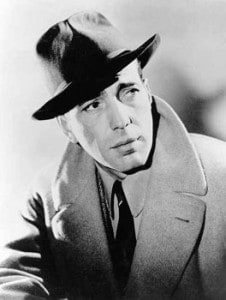“The only thing that you owe the public is a good performance.”—— Humphrey Bogart
The late, great, much-missed Roger Ebert, in his commentary for Casablanca—and no one did film commentaries better, more artfully—spoke most perceptively of “just how good Bogart is.” This was, specifically, Roger’s comparison in that film between Humphrey Bogart and the wooden Paul Henreid, but the assessment would easily apply to almost any of Bogart’s performances in any of his movies, so good was he at what he did.
This observation can further be appreciated and fully digested in the latest compilation of Bogart films from Warner Brothers—not necessarily “just another” of many such releases over the years, but four films have been revitalized in high-definition Blu-ray. And, as well, this may be the first time The Maltese Falcon, Casablanca, The Treasure of the Sierra Madre and The African Queen have been boxed together—a joyous package, indeed—with a multitude of extras.
These four movies represent the pinnacle of Bogart’s incredible and enduring career, perhaps unarguably his four greatest films, period.
To broaden the Bogart/Henreid comparison, Bogie could hold his own against any actor. Surely it’s now passé to still think such from this distance, Bogart having been dead almost sixty years, but it used to be said that he, like Gary Cooper or John Wayne, was merely playing himself. It is actually hard for an actor to play himself and be successful, especially during the long careers of, say, Cooper and Wayne, which ended, not by fading fame or decrepitude, but, in fact, only by death. It must be remembered—surprising to realize when looking back now—that Bogart’s career as a top-billed, major star was atypically short, a mere fifteen years, from his first great success, The Maltese Falcon (some would say High Sierra: no matter, same year, 1941) to his last film, The Harder They Fall (1956). He, too, was deprived of ever making that “next” film, which was to have been Melville Goodwin, U.S.A., filmed in 1957, the year of his death, as Top Secret Affair, with Kirk Douglas and Susan Hayward.
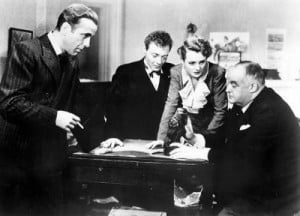 Anyway, among those stars who felt becoming someone else was the measure of acting, who remembers “the great” Paul Muni? Certainly not as well nor as vividly as Bogart. Muni expended enormous effort and much makeup to “get into” his roles, sometimes so much so that he became physically unrecognizable (The Story of Louis Pasteur) or became so egotistical that he damaged the script (Juarez). Bogie always appeared as himself, there in the flesh, an unaltered Humphrey Bogart.
Anyway, among those stars who felt becoming someone else was the measure of acting, who remembers “the great” Paul Muni? Certainly not as well nor as vividly as Bogart. Muni expended enormous effort and much makeup to “get into” his roles, sometimes so much so that he became physically unrecognizable (The Story of Louis Pasteur) or became so egotistical that he damaged the script (Juarez). Bogie always appeared as himself, there in the flesh, an unaltered Humphrey Bogart.
To relate to Bogart’s durability and authenticity, Laurence Olivier, a much higher species of actor than Muni—some would say higher than Bogart, though I would disagree—once remarked that he could approach a role only if he affected a false nose, a beard, an eye patch, a limp, a different hair style or some other “crutch,” if it be called that. In a way, however, he contradicted himself when Dustin Hoffman used a similar aid during the filming of Marathon Man, also starring Olivier. Hoffman, then a newly established method actor, prepared for a scene by going without a few days’ sleep to look scruffy, to be “convincing.” Olivier famously informed him of a simpler solution: “Try acting, dear boy.”
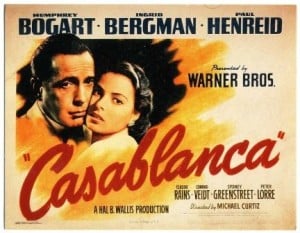 Casablanca, which Ebert placed even above Citizen Kane as the one film he most enjoyed watching, is perhaps Hollywood’s greatest love story—that is, a love story in the style of that Golden Age. Bogart plays disillusioned patriot Rick Blaine, whose saloon and gambling lair is literally thrown into chaos by the arrival of old flame Ilsa (Ingrid Bergman) and her resistance fighter husband, the supposed “true” patriot, Victor Laszlo (Henreid). There is a brief appearance by fugitive Ugarte (Peter Lorre), who ends up dead, but not before he leaves with Rick those famous letters of transit, a character-obsessed McGuffin if ever there was one. Sydney Greenstreet, playing Ferrari, who straddles two cultures, adds leisure and bits of satirical humor to the proceedings.
Casablanca, which Ebert placed even above Citizen Kane as the one film he most enjoyed watching, is perhaps Hollywood’s greatest love story—that is, a love story in the style of that Golden Age. Bogart plays disillusioned patriot Rick Blaine, whose saloon and gambling lair is literally thrown into chaos by the arrival of old flame Ilsa (Ingrid Bergman) and her resistance fighter husband, the supposed “true” patriot, Victor Laszlo (Henreid). There is a brief appearance by fugitive Ugarte (Peter Lorre), who ends up dead, but not before he leaves with Rick those famous letters of transit, a character-obsessed McGuffin if ever there was one. Sydney Greenstreet, playing Ferrari, who straddles two cultures, adds leisure and bits of satirical humor to the proceedings.
The corrupt police official Renault (Claude Rains, almost stealing the show) makes possible the happy ending—well, at least an agreeable one. Ilsa and Laszlo fly off together, for, after all, he is this great freedom fighter and, as Rick says, he needs the strong support of his wife. In the lose of his love—a second time after Paris—Rick is compensated. Besides his already well-established attachment to his saloon pianist Sam (Dooley Wilson), he does have the “beginning of a beautiful friendship” with Renault as they walk off together across the wet tarmac at film’s end.
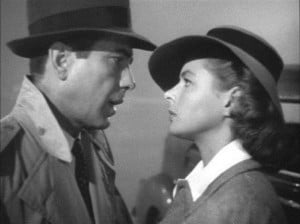 The most important of the Casablanca extras is, indeed, Roger Ebert’s commentary for Bogart’s most famous film. The commentary is reissued yet again—sure—but this scholar and lover of movies provides wonderful insights into both the film and Bogart’s performance. A second commentary, hardly in Ebert’s class, is by fact-obsessed, page-turning Rudy Behlmer. Begin with the Ebert. The documentary “You Must Remember This: A Tribute to Casablanca” first aired on TV in 1992; guests include Lauren Bacall and Pia Lindström, daughter of Ingrid Bergman who had died in 1985, and screenwriters Julius J. Epstein and Howard Koch, then alive. There is also an introduction, also recycled, by Bacall.
The most important of the Casablanca extras is, indeed, Roger Ebert’s commentary for Bogart’s most famous film. The commentary is reissued yet again—sure—but this scholar and lover of movies provides wonderful insights into both the film and Bogart’s performance. A second commentary, hardly in Ebert’s class, is by fact-obsessed, page-turning Rudy Behlmer. Begin with the Ebert. The documentary “You Must Remember This: A Tribute to Casablanca” first aired on TV in 1992; guests include Lauren Bacall and Pia Lindström, daughter of Ingrid Bergman who had died in 1985, and screenwriters Julius J. Epstein and Howard Koch, then alive. There is also an introduction, also recycled, by Bacall.
The first of these four films to be made, The Maltese Falcon is a close collaboration among director John Huston, his cinematographer Arthur Edeson and his major stars: Bogart, Mary Astor, Sydney Greenstreet and Peter Lorre. As each would say later, they knew they were working on something special. The movie defined both the detective genre and film noir, as if there had been neither before it.
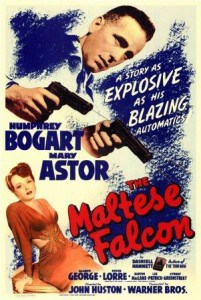 And Bogart literally, overnight, defined the image of the private dick—forever resolute, cynical, emotionally hard and always looking out for his own interests. Undoubtedly Sam Spade is just a little too hard, too insensitive. He is unmoved by the murder of his partner (Jerome Cowan) and dismissive of his partner’s wife (Gladys George), with whom he is having an affair. And Spade doesn’t come out ahead at the end, either. The film has a downer finish. The valuable bird statuette which everybody was after proves to be a fake and the gal (Astor) Spade found along the way, among the intricacies of plot and the abundant violence, was only using him. Using his natural instincts, however, he is able, like a cat, to land on his feet and recoup the respect of his police buddies (Ward Bond and Barton MacLane). Until next time, that is—and, perhaps, the next femme fatale.
And Bogart literally, overnight, defined the image of the private dick—forever resolute, cynical, emotionally hard and always looking out for his own interests. Undoubtedly Sam Spade is just a little too hard, too insensitive. He is unmoved by the murder of his partner (Jerome Cowan) and dismissive of his partner’s wife (Gladys George), with whom he is having an affair. And Spade doesn’t come out ahead at the end, either. The film has a downer finish. The valuable bird statuette which everybody was after proves to be a fake and the gal (Astor) Spade found along the way, among the intricacies of plot and the abundant violence, was only using him. Using his natural instincts, however, he is able, like a cat, to land on his feet and recoup the respect of his police buddies (Ward Bond and Barton MacLane). Until next time, that is—and, perhaps, the next femme fatale.
The Maltese Falcon includes fewer extras than Casablanca, though they are still enticing. The commentary here is by biographer Eric Lax, who is perhaps best known for his book Conversations with Woody Allen. The studious quality of the short “The Maltese Falcon: One Magnificent Bird” from 2006 is offset by the hilarity of one of those yearly studio blooper reels, from Warner films of 1941.
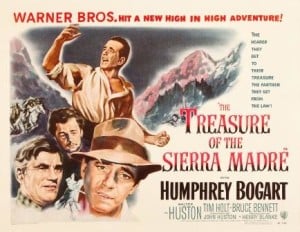 In The Treasure of the Sierra Madre, Bogart plays conceivably the most despicable character of his mature career, a carefully gauged performance as novice gold prospector Fred C. Dobbs. Almost from the first, Bogart infuses in his character the subtlest smell of duplicity, a vague unpleasantness. Before long, after hints of paranoia from the first, Dobbs becomes more suspicious of his partners (Walter Huston and Tim Holt), until, finally, out of control and rocking back and forth and laughing sinisterly, he ends up shooting one of them. But a more final end awaits Dobbs at the hands of a Mexican bandit (Alfonso Bedoya).
In The Treasure of the Sierra Madre, Bogart plays conceivably the most despicable character of his mature career, a carefully gauged performance as novice gold prospector Fred C. Dobbs. Almost from the first, Bogart infuses in his character the subtlest smell of duplicity, a vague unpleasantness. Before long, after hints of paranoia from the first, Dobbs becomes more suspicious of his partners (Walter Huston and Tim Holt), until, finally, out of control and rocking back and forth and laughing sinisterly, he ends up shooting one of them. But a more final end awaits Dobbs at the hands of a Mexican bandit (Alfonso Bedoya).
The negative qualities of Dobbs had already surfaced in the mid-’40s in Bogart’s two wife-killing roles in Conflict and The Two Mrs. Carrolls. Perhaps drawing on his cruel gangster parts of the ’30s, and as age precluded even him from continuing forever as a romantic lead, he turned to a variety of parts, some negative—an unhinged captain in The Caine Mutiny, an escaped convict in the comedy We’re No Angels, a cruel killer in The Desperate Hours and a cynical sportswriter in The Harder They Fall.
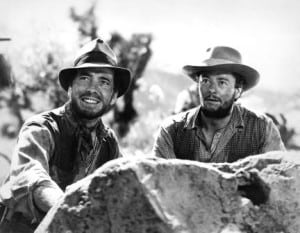 Eric Lax also provides the commentary for The Treasure of the Sierra Madre, which is further supported by a making-of documentary and a profile of its director John Huston.
Eric Lax also provides the commentary for The Treasure of the Sierra Madre, which is further supported by a making-of documentary and a profile of its director John Huston.
In the most recent film of the boxed set, and the only one in color, The African Queen, Bogart craftily combines a sloppy, stub-bearded boat captain (Charlie Allnut) with a romantic lead—of sorts. Spinster Rosie Sayer (Katharine Hepburn), whose brother (Robert Morley) dies from trauma incurred after an attack by German soldiers at the beginning of World War I, joins Charlie in traversing a river in his little boat with the temperamental boiler, the African Queen.
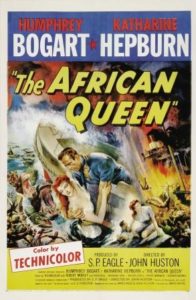 Each has work to do: Charlie to break through Rosie’s puritanical wall, and she, with perhaps an even more daunting task, to strengthen his weak backbone and convince him to embrace her scheme to sink a German gunboat, Queen Louisa, that patrols a large lake at the base of the river. Their growing friendship soon turns into love, and they work together to improvise two torpedoes from empty oxygen cylinders, affixing them to the bow of the African Queen.
Each has work to do: Charlie to break through Rosie’s puritanical wall, and she, with perhaps an even more daunting task, to strengthen his weak backbone and convince him to embrace her scheme to sink a German gunboat, Queen Louisa, that patrols a large lake at the base of the river. Their growing friendship soon turns into love, and they work together to improvise two torpedoes from empty oxygen cylinders, affixing them to the bow of the African Queen.
The movie was filmed in Africa—on the Ruiki River in Tanzania, near the village of Butiaba and at Murchison Falls, both in Uganda. And filming was not accomplished without great difficulties, as Huston relates in his autobiography, An Open Book. Everything seemed to go wrong, evidence of the perils of filming on location. There were soldier ants, black wasp attacks, incessant rains, black mambas in the toilets, the little boat sank and everyone caught diarrhea, except Huston and Bogart, who credited their exemption to drinking scotch with their water.
The African Queen has one extra, a sixty-minute documentary “Embracing Chaos: The Making of The African Queen,” with Bacall once again, Tony Huston, Theodore Bikel, who played the first officer of the Queen Louisa, and, in archival footage, John Huston, Hepburn and the film’s cinematographer Jack Cardiff.
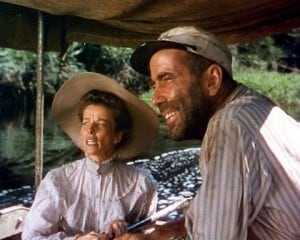 As kind of a tally, three of the films were directed by Huston (all but Casablanca, which was directed by Michael Curtiz), all were made by Warner Bros. except The African Queen, two were photographed by Arthur Edeson (The Maltese Falcon and Casablanca) and two were scored by composer Max Steiner (Casablanca and The Treasure of the Sierra Madre).
As kind of a tally, three of the films were directed by Huston (all but Casablanca, which was directed by Michael Curtiz), all were made by Warner Bros. except The African Queen, two were photographed by Arthur Edeson (The Maltese Falcon and Casablanca) and two were scored by composer Max Steiner (Casablanca and The Treasure of the Sierra Madre).
If possibly incurring accusations of immodesty, Humphrey Bogart knew he was good and often said so. Roger Ebert didn’t have to announce it.
Sadly though, as good as these four films are, the fact remains that the guts of this presentation isn’t new. Merely the packaging has been changed. If you already have these from their own respective individual blu-ray release, there is no need to purchase them again. These are the same releases.
Only on the rare chance that you don’t should you entertain a purchase here, as even owning one of them individually offsets the meager savings presented in purchasing the four-pack. The inclusion of a new to blu release such as To Have and Have Not would have been ideal here. But we digress.
Review copy provided by Warner Bros. Thanks!
